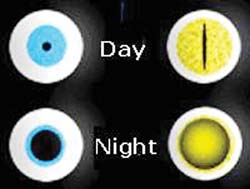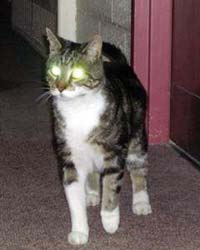Nature
trail
Do all animals see
in colour?
The world we live in is a myriad (great amount) of colours.
Everywhere we look, we can see spectacular hues of reds, greens, blues,
yellows and so on. These beautiful colours are naturally attractive and
very pleasing to the eye.
  We
humans are fortunate in being able to see and appreciate these wonderful
colours. It is due to the type of vision humans are endowed with that we
can see the world in colour. However, not all the species in the animal
kingdom can see in colour. So, letís examine which animals cannot see
colours and why. We
humans are fortunate in being able to see and appreciate these wonderful
colours. It is due to the type of vision humans are endowed with that we
can see the world in colour. However, not all the species in the animal
kingdom can see in colour. So, letís examine which animals cannot see
colours and why.
The colour vision and perception (knowledge of something through
senses) across the animal kingdom is the subject of much ongoing
research because it is not easy to determine what a particular animal
sees through its eyes.
We obviously cannot see through their eyes, so scientists can only
make an educated guess about the visual spectrum of animals based on the
various tests and research carried out over the years.
According to scientific research, perception of colour is determined
by the presence of cone photoreceptors within the retina. If you are not
aware as to what the retina is, it is the layer at the back of the
eyeball which is sensitive to light.
The eyes of most animals contain an optical system that produces an
image of the world onto a large number of light detectors.
Studies have shown that we detect light with our eyes, but we see
with our brain. Light signals received by our eyes are sent to the
brain. The brain then decides, with the aid of previous experience, what
we are looking at. It is this process that is called perception by
scientists.
 Many
scientists believe that animals understand very little of what they
actually see. In fact some have the view that animals see things the way
some humans see abstract paintings, rarely understanding what the artist
is trying to portray. Many
scientists believe that animals understand very little of what they
actually see. In fact some have the view that animals see things the way
some humans see abstract paintings, rarely understanding what the artist
is trying to portray.
Even though the understanding about animal vision is limited, what
the scientists have discovered so far is very fascinating.
However, some claim that what we know about colour perception in
animals pales in comparison to that yet to be discovered.
 An
animal can see in colour if it can differentiate between different
wavelengths, according to scientists. They have discovered that though
mammals have relatively weak colour vision, humans and other animals
that are known as primates within the mammalian family have the most
advanced colour perception within this class. An
animal can see in colour if it can differentiate between different
wavelengths, according to scientists. They have discovered that though
mammals have relatively weak colour vision, humans and other animals
that are known as primates within the mammalian family have the most
advanced colour perception within this class.
Old World primates such as the great apes, macaque and monkeys have
colour vision based upon three different cone types which are very
similar to that of most humans. Mammals that are not primates have only
two cone types.
Scientists have discovered enormous diversity in the retinal
structure and neuronal mechanisms within the animal kingdom. It is a
known fact that the position of the eye within the head determines the
degree of peripheral (surrounding region) vision. The binocular vision
is also necessary for the judgment of distance.
Many of you who have cats and dogs as pets would be now keen to know
whether your beloved pets could also see the world as you see it....in
colour! Well, until recently it was commonly believed that our canine
friends could see only black and white.
And so, it was believed that dogs saw the world the way we see black
and white photographs, but not as distinctly.
However, recent studies have revealed otherwise. Those of you who
were so far not aware of this fact are bound to be excited to learn that
your doggie friends and cats too have some degree of colour vision.
Tests carried out on dogs have revealed that they can distinguish the
colours red and blue, but are often confused with red and green.
It is generally accepted that their colour spectrum is very limited.
Even though blue may be visible, colours such as red, green and yellow
may appear similar to them. They are believed to be colour blind, like
some humans who also cannot differentiate between red and green.
However, donít think that what your pet dogs see is as vibrantly
coloured as what you see.
  What
they generally see are pale shades of colour, more like a washed out
image of what we humans see. But, dogs have better night vision. They
also have a higher vision field than that of humans; dogs have their
eyes set on either side of their head, so their vision field is 240
degrees compared with the 200 degree vision field of humans. Dogs can
distinguish an object that humans could see at 90 feet, only at 20 feet! What
they generally see are pale shades of colour, more like a washed out
image of what we humans see. But, dogs have better night vision. They
also have a higher vision field than that of humans; dogs have their
eyes set on either side of their head, so their vision field is 240
degrees compared with the 200 degree vision field of humans. Dogs can
distinguish an object that humans could see at 90 feet, only at 20 feet!
The colour vision of cats is believed to be poorer than that of dogs
since they rely almost entirely on rod cells for their vision. But in
general, cats can see as well as humans. Cats appear to be slightly near
sighted because their vision is tailored more for closer objects. Cats
have an elliptical pupil which opens and closes much faster than round
types of pupils. This allows for a proportionately larger pupil size,
letting in more light.
Even though most cats detect very little colour they can see much
better at night than humans, with eyes that are very sensitive to
movement.
Cats have two distinct types of light sensitive cells in the eye
(retina) like humans have. They are rods and cones. Rods are receptors
used by the eye in the night, especially to detect movement. Cones are
used during daytime to process information. The ratio of rods to a cone
in cats is 25:1 while itís 4:1 in humans.
It is a fact that cats have visual acuity (ability to focus) that is
much greater than that of humans, and also that they can see better than
us in the night. But, even cats need some glimmer of light to see at
night.
Now that we know something about how cats and dogs see the world,
letís check out about some other animals next week.
Facts and pix: Internet.
---------------------
Fast facts
* Humans have colour vision produced by three different retinal cone
cells called trichomatic vision. Our colour sensitivity extends to three
different wavelengths of light; red, green and blue.
* Ultraviolet light lies beyond the blue, indigo and violet end of
the visible spectrum of electromagnetic radiation.
* Light at the far-end of the so-called visible spectrum has the
longest wavelength of all-around 0.73 to 0.8 micrometres. Itís not
visible to human eyes, but some animals, including the dragonfish can
see it.
* The visible spectrum comprises seven colours-red, orange, yellow,
green, blue, indigo and violet - the colours of the rainbow.
* Electromagnetic radiation consists of the energy waves associated
with electric and magnetic waves, and results from the acceleration of
an electric charge.
* The types of electromagnetic radiation are radio waves, infrared,
visible light, x-ray and gamma rays.
------***** |


